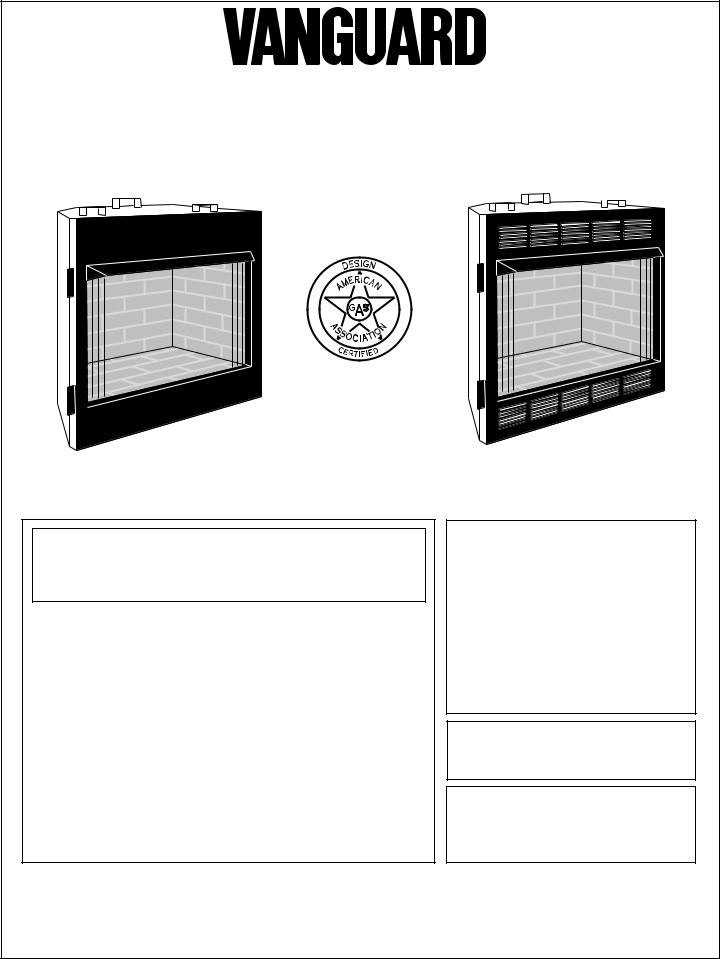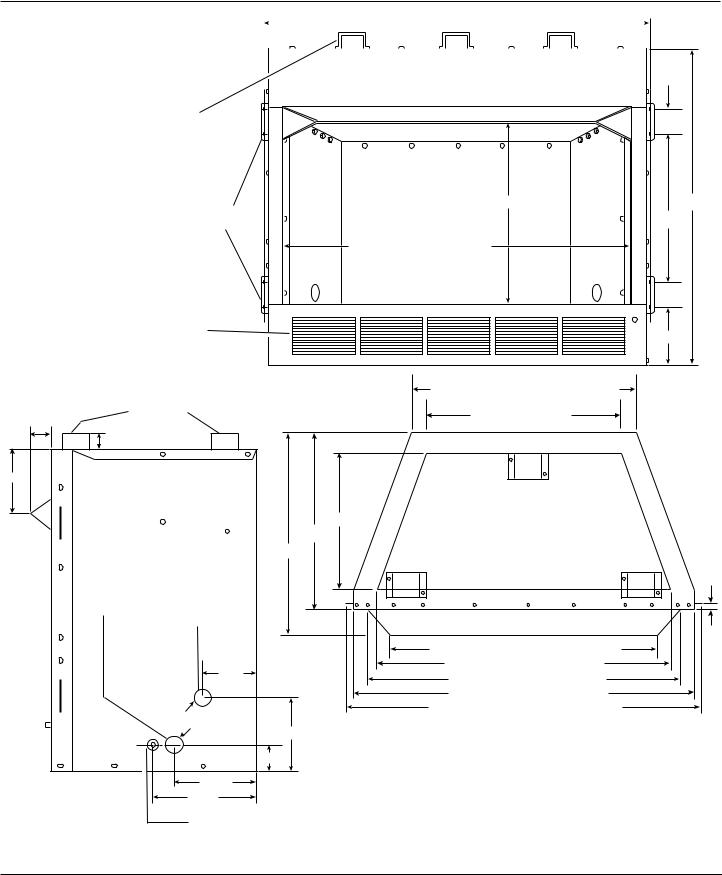Desa Tech FB36CB, FB36NCA, FB42CA, FB42NC Owner's Manual

®
UNVENTED (VENT-FREE)
LogMate™ UNIVERSAL FIREBOX
OWNER’S OPERATION AND INSTALLATION MANUAL
®
FB36NCA and FB42NC
Non-circulating Models
WARNING: If the information in this manual is not followed exactly, a fire or explosion may result causing property damage, personal injury, or loss of life.
—Do not store or use gasoline or other flammable vapors and liquids in the vicinity of this or any other appliance.
—WHAT TO DO IF YOU SMELL GAS
•Do not try to light any appliance.
•Do not touch any electrical switch; do not use any phone in your building.
•Immediately call your gas supplier from a neighbor’s phone. Follow the gas supplier’s instructions.
•If you cannot reach your gas supplier, call the fire department.
—Installation and service must be performed by a qualified installer, service agency, or the gas supplier.
FB36CB and FB42CA
Circulating Models
WARNING: Improper installation, adjustment, alteration, service, or maintenance can cause injury or property damage. Refer to this manual for correct installation and operational procedures. For assistance or additional information consult a qualified installer, service agency, or the gas supplier.
WARNING: For use only with decorative type unvented room heaters. Do not build a wood fire.
This firebox has been tested and approved by I.A.S. under their REQ. 2-97 for use with any ANS Z21.11.2 approved gas logs.
This firebox may be installed in an aftermarket* manufactured (mobile) home, where not prohibited by state or local codes.
* Aftermarket: Completion of sale, not for purpose of resale, from the manufacturer (i.e. Installation of this product is permitted after the manufactured (mobile) home is sited).
Save this manual for future reference.

VANGUARD
UNVENTED (VENT-FREE) LOGMATE™ FIREBOX
SAFETY
INFORMATION
 WARNINGS
WARNINGS
IMPORTANT: Read this owner’s manual carefully and completely before trying to assemble, operate, or service this firebox. Improperuseofthisfireboxcancause serious injury or death from burns, fire, explosion, electrical shock, or carbon monoxide poisoning.
 CAUTION: Carefully review the instructions supplied with the decorative type unvented room heater for the minimum fireplace size requirement. Do not install the appliance in this firebox unless this firebox meets the minimum dimensions required for the installation.
CAUTION: Carefully review the instructions supplied with the decorative type unvented room heater for the minimum fireplace size requirement. Do not install the appliance in this firebox unless this firebox meets the minimum dimensions required for the installation.
 WARNING: Any change to this firebox or its controls can be dangerous.
WARNING: Any change to this firebox or its controls can be dangerous.
1.This firebox shall not be installed in a bedroom or bathroom.
2.Never install the firebox
•in a recreational vehicle
•where curtains, furniture, clothing, or other flammable objects are less than 36 inches from the front, top, or sides of the firebox
•in high traffic areas
•in windy or drafty areas
3.Do not use this firebox as a wood-burn- ing fireplace. Use only decorative unvented room heaters (log sets).
4.Do not add extra logs or ornaments such as pine cones, vermiculite, or rock wool. Using these added items can cause sooting.
5.You must operate this fireplace with the provided fireplace screen, hood, and brick liner in place. Make sure these parts are in place and screens are closed before running firebox. The supplied hood may not be replaced with a hood which may be provided with a log heater.
6.Do not allow fans to blow directly into the firebox. Avoid any drafts that alter burner flame patterns. Ceiling fans can create drafts that alter burner flame patterns. Altered burner patterns can cause sooting.
7.Do not use a blower insert, heat exchanger insert or other accessory not approved for use with this heater. Do not use blower accessory with Models FB36NCA or FB42NC. Use only the provided hood, or appropriate polished brass hood accessory. See Accessories on page 18.
8.Vent-free gas log heaters installed in these fireboxes require fresh air ventilation to run properly. See Air for Combustion and Ventilation, pages 5 through 7.
9.Do not run firebox
•where flammable liquids or vapors are used or stored
•under dusty conditions
10.Do not use this firebox to cook food or burn paper or other objects.
11.Never place any objects in the firebox or on logs.
12.Firebox front and screen becomes very hot when running firebox. Keep children and adults away from hot surfaces to avoid burns or clothing ignition. Firebox will remain hot for a time after shut-down. Allow surfaces to cool before touching.
13.Carefully supervise young children when they are in the room with firebox.
14.Turn firebox off and let cool before servicing. Only a qualified service person should service and repair firebox.
15.Operating firebox above elevations of 4,500 feet could cause pilot outage.
16.Do not use the firebox if it has been under water due to the shock hazard that could result with the blower accessary (if installed) in place.
2 |
104654 |

OWNER’S MANUAL
LOCAL CODES
Install and use fireplace with care. Follow all local codes. In the absence of local codes, use the latest edition of The National Fuel Gas Code ANS Z223.1, also known as NFPA 54*. Firebox must be electrically grounded in accordancewiththeNationalElectricalCode, ANS/NFPA70 (latest edition).
*Available from:
American National Standards Institute, Inc.
1430 Broadway
New York, NY 10018
National Fire Protection Association, Inc.
Batterymarch Park
Quincy, MA 02269
UNPACKING
1.Use utility knife to cut carton all the way around above the staples on the bottom tray. Lift carton off the firebox and discard.
2.Remove all protective packaging from inside firebox. Carefully lift the firebox off the bottom corrugated tray.
3.Check carton contents for the following:
•Screen assembly
•Screen support rod
•Hardware and parts bag containing the following:
-Owners Operation and Installation Manual
-2 - Black #10 x 3/8" Phillips screws for mounting screen support rods
If any items are missing, inform dealer where you bought firebox.
4.Check all items for any shipping damage. If damaged, promptly inform dealer where you bought firebox.
Notice: The firebox identification label (including model number, serial number, clearances, etc.) is located either on the left front edge of the firebox or behind the left side firebrick panel. See Figure 15, page 11.
PRODUCT
FEATURES
Operation
This firebox is designed for use with approved ANS Z21.11.2 decorative type unvented room heaters. (Physical size limitations apply. Refer to minimum firebox requirements supplied with log heater.) It requires no outside venting or chimney making installation easy and inexpensive. When used without the blower (models FB36CB or FB42CA only), the firebox requires no electricity making it ideal for emergency backup heat.
Blower Accessory
The FB36CB or FB42CA fireboxes will accept the GA3700 accessory. The variable blower allows you to select the fan speed you desire. The blower circulates heated air from the firebox into the room. Use of blower is optional.
Brick Liner
This firebox features concrete brick liner. As with all concrete liners, this liner may develop slight cracks when exposed to heat. These cracks will not affect the performance of the fireplace or vent-free gas logs.
LOCATING
FIREBOX
Planning
Plan where you will install the firebox. This will save time and money later when you install the firebox. Before installation, consider the following:
1.Where the firebox will be located. Allow for wall and ceiling clearances (see
Installation Clearances, page 8).
2.Everything needed to complete installation.
3.These models CANNOT be installed in a bedroom or bathroom.
4.Proper air for combustion and ventilation (page 5).
104654 |
3 |

VANGUARD
UNVENTED (VENT-FREE) LOGMATE™ FIREBOX
PRODUCT |
|
|
|
|
|
|
|
|
41 11/16" (36" models) • 47 11/16" (42" models) |
|
|
|
|
|
||||||||||
SPECIFICATIONS |
|
|
|
|
|
|
|
|
|
|||||||||||||||
|
|
|
|
|
|
|
|
|
|
|
|
|
|
|
|
|
|
|
|
|
|
|
|
|
|
|
|
|
|
|
|
|
|
|
|
|
|
|
|
|
|
|
|
|
|
|
|||
|
Standoffs |
|
2 5/8" |
|
|
|
|
|
|
19 3/8" |
35" |
|
Built-in Nailing |
|
15 7/8" |
|
Flanges |
|
|
|
|
36" (36" models) • 42" (42" models) |
|
|
Louvers |
|
2 5/8" |
|
|
|
|
|
(Models FB36CB |
|
|
|
and FB42CA only) |
|
6 5/8" |
|
|
|
|
Figure 1 - Firebox Front View |
|
|
|
|
Standoffs |
29 1/8" (36" Models) • 35 1/8" (42" Models) |
|
|
22 3/4" (36" Models) • |
|
|
|
|
|
|
1 1/2" |
28 3/4" (42" Models)* |
|
|
|
|
||
2 3/4" |
|
|
|
8 7/16" |
|
|
|
Electrical Access |
|
|
|
Hole |
(for use |
14 1/4" |
|
when using |
|
||
19 1/2" |
|
||
blower power |
|
||
22 1/4" |
|
||
cord with external |
|
||
electrical outlet. |
|
|
|
See Blower Kit |
|
5/8" |
|
Instructions) |
|
|
|
|
Gas Line Access |
|
|
|
Hole (either side) |
|
|
|
|
30 3/8" (36" Models) • 36 7/8" (42" Models) |
|
|
6 7/8" |
34" (36" Models) • 40" (42" Models)* |
|
|
36" (36" Models) • 42" (42" Models) |
|
|
|
|
|
|
|
|
41" (36" Models) • 47" (42" Models) |
|
|
1 1/2" |
42 3/8" (36" Models) • 48 3/8" (42" Models) |
|
|
|
|
|
|
Diameter Holes |
*Interior Dimensions Within Brick Liner |
|
|
|
9 5/8" |
|
|
|
Figure 3 - Firebox Top View |
|
|
|
3 1/2" |
|
|
10 3/4" |
|
|
13 9/16"
Electrical Access Hole
Strain relief fitting for electrical cable when hard wiring firebox for built-in installations (strain relief
fitting included on circulating models only)
Figure 2 - Firebox Side View
4 |
104654 |

OWNER’S MANUAL
AIR FOR COMBUSTION AND VENTILATION
 WARNING: This firebox shall not be installed in a confined space unless provisions are provided for adequate combustion and ventilation air. Read the following instructions to insure proper fresh air for this and other fuel-burning appliances in your home.
WARNING: This firebox shall not be installed in a confined space unless provisions are provided for adequate combustion and ventilation air. Read the following instructions to insure proper fresh air for this and other fuel-burning appliances in your home.
Today’s homes are built more energy efficient than ever. New materials, increased insulation, and new construction methods help reduce heat loss in homes. Home owners weather strip and caulk around windows and doors to keep the cold air out and the warm air in. During heating months, home owners want their homes as airtight as possible.
While it is good to make your home energy efficient, your home needs to breathe. Fresh air must enter your home. All fuel-burning appliances need fresh air for proper combustion and ventilation.
Exhaust fans, fireboxes, clothes dryers, and fuel burning appliances draw air from the house to operate. You must provide adequate fresh air for these appliances. This will insure proper venting of vented fuelburning appliances.
PROVIDING ADEQUATE VENTILATION
The following is exerpts from National Fuel Gas Code. NFPA 54/ANS Z223.1, Section 5.3, Air for Combustion and Ventilation.
All spaces in homes fall into one of the three following ventilation classifications:
1.Unusually Tight Contruction
2.Unconfined Space
3.Confined Space
The information on pages 5 through 7 will help you classify your space and provide adequate ventilation.
Unusually Tight Construction
The air that leaks around doors and windows may provide enough fresh air for combustion and ventilation. However, in buildings of unusually tight construction, you must provide additional fresh air.
Unusually tight construction is defined as construction where:
a.walls and ceilings exposed to the outside atmosphere have a continuous water vapor retarder with a rating of one perm (6 x 10-11 kg per pa-sec-m2) or less with openings gasketed or sealed and
b.weather stripping has been added on openable windows and doors and
c.caulking or sealants are applied to areas such as joints around window and door frames, between sole plates and floors, between wall-ceiling joints, between wall panels, at penetrations for plumbing, electrical, and gas lines, and at other openings.
If your home meets all of the three criteria above, you must provide additional fresh air. See Ventilation Air From Outdoors, page 7.
If your home does not meet all of the three criteria above, proceed to Determining Fresh-Air Flow for Firebox Location, page 6.
Confined and Unconfined Space
The National Fuel Gas Code (ANS Z223.1, 1992 Section 5.3) defines a confined space as a space whose volume is less than 50 cubic feet per 1,000 Btu per hour (4.8 m3 per kw) of the aggregate input rating of all appliances installed in that space and an unconfined space as a space whose volume is not less than 50 cubic feet per 1,000 Btu per hour (4.8 m3 per kw) of the aggregate input rating of all appliances installed in that space. Rooms communicating directly with the space in which the appliances are installed*, through openings not furnished with doors, are considered a part of the unconfined space.
This heater shall not be installed in a confined space or unusually tight construction unless provisions are provided for adequate combustion and ventilation air.
* Adjoining rooms are communicating only if there are doorless passageways or ventilation grills between them.
Continued
104654 |
5 |

VANGUARD
UNVENTED (VENT-FREE) LOGMATE™ FIREBOX
AIR FOR
COMBUSTION AND
VENTILATION
Continued
DETERMINING FRESH-AIR FLOW FOR FIREBOX LOCATION
Determining if You Have a Confined or Unconfined Space
Use this work sheet to determine if you have a confined or unconfined space.
Space: Includes the room in which you will install firebox plus any adjoining rooms with doorless passageways or ventilation grills between the rooms.
1.Determine the volume of the space (length x width x height).
Length x Width x Height = ________ _________ cu. ft. (volume of space)
Example: Space size 22 ft. (length) x 18 ft. (width) x 8 ft. (ceiling height) = 3168 cu. ft. (volume of space)
If additional ventilation to adjoining room is supplied with grills or openings, add the volume of these rooms to the total volume of the space.
2.Divide the space volume by 50 cubic feet to determine the maximum Btu/Hr the space can support.
_____________ (volume of space) ÷ 50 cu. ft. = (Maximum Btu/Hr the space can support)
Example: 3168 cu. ft. (volume of space) ÷ 50 cu. ft. = 63.3 or 63,300 (maximum Btu/Hr the space can support)
3.Add the Btu/Hr of all fuel burning appliances in the space.
Vent-free firebox |
_______________ |
Btu/Hr |
Example: |
|
|
|
|
Gas water heater* |
_______________ |
Btu/Hr |
|
|
|
||
Gas water heater |
|
40,000 |
Btu/Hr |
||||
Gas furnace |
_______________ |
Btu/Hr |
|
||||
Vent-free firebox |
|
|
|
||||
Vented gas heater |
_______________ |
Btu/Hr |
+ |
|
|
||
with log heater |
39,000 |
Btu/Hr |
|||||
Gas firebox logs |
_______________ |
Btu/Hr |
|||||
|
= |
|
|
||||
Total |
79,000 |
Btu/Hr |
|||||
Other gas appliances* |
+ ______________ Btu/Hr |
||||||
|
|
|
|
||||
|
|
|
|
||||
Total |
= ______________ |
Btu/Hr |
|
|
|
|
|
*Do not include direct-vent gas appliances. Direct-vent draws combustion air from the outdoors and vents to the outdoors.
4.Compare the maximum Btu/Hr the space can support with the actual amount of Btu/Hr used.
______________ Btu/Hr (maximum the space can support)
______________ Btu/Hr (actual amount of Btu/Hr used)
Example: 63,300 Btu/Hr (maximum the space can support)
79,000 Btu/Hr (actual amount of Btu/Hr used)
The space in the above example is a confined space because the actual Btu/Hr used is more than the maximum Btu/Hr the space can support. You must provide additional fresh air. Your options are as follows:
A.Rework work sheet, adding the space of an adjoining room. If the extra space provides an unconfined space, remove door to adjoining room or add ventilation grills between rooms. See Ventilation Air from Inside Building, page 7.
B.Vent room directly to the outdoors. See Ventilation Air from Outdoors, page 7.
C.Install a lower Btu/Hr firebox, if lower Btu/Hr size makes room unconfined.
If the actual Btu/Hr used is less than the maximum Btu/Hr the space can support, the space is an unconfined space. You will need no additional fresh air ventilation.
 WARNING: If the area in which the firebox and gas log heater may be operated is smaller than that defined as an unconfined space or if the building is of unusually tight construction, provide adequate combustion and ventillation air by one of the methods described in the National Fuel Gas Code, ANS Z223.1, 1992, Section 5.3 or applicable local codes.
WARNING: If the area in which the firebox and gas log heater may be operated is smaller than that defined as an unconfined space or if the building is of unusually tight construction, provide adequate combustion and ventillation air by one of the methods described in the National Fuel Gas Code, ANS Z223.1, 1992, Section 5.3 or applicable local codes.
6 |
104654 |
